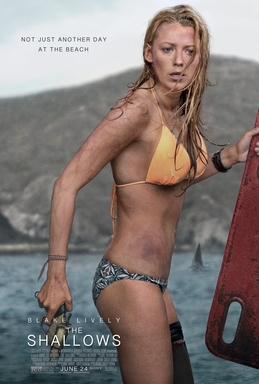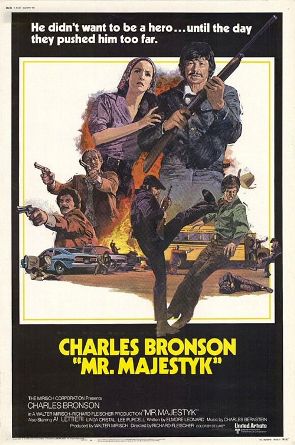Have you seen The Shallows yet?
The Shallows was released last week, to strong box office and surprisingly good reviews. Ever since it came out, people have been telling me, “You have got to see The Shallows!” Well, I finally did see it earlier today and you know what? I should have seen it earlier. The Shallows is one of the best films of the year so far.
Now, I have to admit that, even before I saw the film, I was pretty sure that I was going to like it. Just from watching the trailer, The Shallows looked like a big-budget Asylum film or maybe a mainstream version of Shark Exorcist. After all, here we had a movie about a blonde in bikini being menaced by a giant shark while stranded on a rock in the middle of the ocean. It looked like it would be one of those big, over-the-top nature-gone-crazy movies that I always enjoy watching on SyFy.
And, to a certain extent, it is. The Shallows was directed by Jaume Collet-Serra, a Spanish director whose previous work would seem to indicate an appreciation for old school grindhouse and drive-in cinema. There’s really not a subtle moment to be found in The Shallows. The shark is huge and whenever it finds something to eat, the ocean turns red with blood and while this grudge-holding shark may not behave like a real-life shark, it does behave like a movie shark. When, at the start of the film, Lively is on her surfboard and blissfully unaware of the danger under the sea, girl power anthems blast on the soundtrack. Whenever the camera briefly pans underwater for a shot from the shark’s point of view, the music suddenly becomes ominous and full of menace. The action is nearly non-stop, pausing only occasionally for a few moments when the camera lingers on Lively either stretching on the beach or resting on the rock and yet the cinematography is so stunning and Lively’s performance is so great that these shots don’t feel exploitive but instead celebrate her both her outer and her inner strength. Undoubtedly, a lot of people are buying tickets because Blake Lively spends most of the movie in a bikini but The Shallows is still one of the most empowering films of the summer.
That’s right, I just said that Blake Lively gives a great performance. I have to admit that, despite loving Gossip Girl, I was never really sold on Blake Lively as an actress until I saw her in The Shallows. I thought she was wasted in The Town and her performance in Savages left me so annoyed that I was literally screaming in the theater. But no matter — Blake Lively proves herself to truly be a talented actress in The Shallows. From the minute she appears onscreen, you’re on her side. You’re happy for her when she finally gets to surf the beach that her recently deceased mother surfed when she was young. You fear for her when the shark makes its first blink-and-you’ll-miss-it appearance. And when she’s stranded on that rock, fighting for her own survival and trying to figure out a way to close a huge gash on her leg (and this was a scene that I literally watched through my fingers), you find yourself truly fearful that she’ll never be rescued. (One of the strengths of the film is that you’re never fully convinced that Lively is going to survive her ordeal.) Blake Lively gives a performance here that I would compare to James Franco’s breakthrough work in 127 Hours.
Actually, a lot of the scenes in The Shallows reminded me of 127 Hours. For that matter, there were also a few scenes that reminded me of Wild and, of course, the Jaws influence was obvious as well. The Shallows is a derivative film but, to its credit, it borrows from the best and Collet-Serra always manages to add his own individual spin to even the film’s most predictable moments.
Along with Lively’s performance and Collet-Serra’s direction, there are three other things that make The Shallows special.
Number one, it features an amazing seagull. The seagull, which has an injured wing, spends most of the movie hanging out with Blake Lively on that rock and provides her with some much needed companionship. The seagull also happens to be a helluva actor and, at times, I found myself even more worried about the seagull’s survival than Lively’s. According to the credits, the seagull’s name is Sully and he better get some love from the Academy next January.
Number two, there’s a scene in which two soon-to-be-doomed surfers ask Blake Lively if she’s from California. “No,” Lively replies, “Texas!” From the minute she said that, all of us at the Alamo Drafthouse were on her side. And, just in case any of you northerners have any doubts, people do surf in Texas. Just ask anyone who has ever spent spring break in Galveston or Corpus Christi.
Finally, The Shallows is a short movie and, after sitting through so many overlong movies, it was nice to see a movie that was direct and to the point and which did not include any unnecessary padding. The Shallows only needed 86 minutes to tell its story and not a minute more!
(Compare the 86-minute The Shallows to the 151-minute Batman v Superman and you’ll understand what film critics mean when they complain about a film being overlong.)
With its truly breathtaking shots of the ocean and it’s nonstop action, The Shallows is a film that you owe it to yourself to see on a big screen. So get to it!




 What happens when you combine the great tough guy writer Elmore Leonard with the great tough guy actor Charles Bronson?
What happens when you combine the great tough guy writer Elmore Leonard with the great tough guy actor Charles Bronson?
 After tough New York detective Lou Torrey (Charles Bronson) lands in hot water for shooting and killing a teenage cop killer, he moves to Los Angeles and gets a job with the LAPD. Working under an unsympathetic supervisor (Norman Fell), saddled with an incompetent partner (Ralph Waite), and surrounded by paper pushing bureaucrats, Torrey still tries to uphold the law and dispense justice whenever he can. When a heroin dealer is murdered while in Torrey’s custody, Torrey suspects that it might be a part of a larger conspiracy, involving mobster Al Vescari (Martin Balsam).
After tough New York detective Lou Torrey (Charles Bronson) lands in hot water for shooting and killing a teenage cop killer, he moves to Los Angeles and gets a job with the LAPD. Working under an unsympathetic supervisor (Norman Fell), saddled with an incompetent partner (Ralph Waite), and surrounded by paper pushing bureaucrats, Torrey still tries to uphold the law and dispense justice whenever he can. When a heroin dealer is murdered while in Torrey’s custody, Torrey suspects that it might be a part of a larger conspiracy, involving mobster Al Vescari (Martin Balsam).













